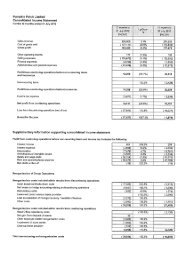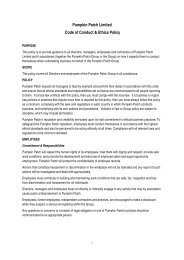annual report 2012 - Pumpkin Patch investor relations
annual report 2012 - Pumpkin Patch investor relations
annual report 2012 - Pumpkin Patch investor relations
- No tags were found...
Create successful ePaper yourself
Turn your PDF publications into a flip-book with our unique Google optimized e-Paper software.
pumpkin patch limited & subsidiaries NOTES TO THE financial statements 31 july <strong>2012</strong>pumpkin patch limited & subsidiaries NOTES TO THE financial statements 31 july <strong>2012</strong>25 Financial risk management (iii) Summarised sensitivity analysisThe Group’s activities expose it to a variety of financial risks: market risk (includingcurrency risk and interest rate risk), credit risk and liquidity risk. The Group’s overallrisk management programme focuses on the unpredictability of financial markets andseeks to minimise potential adverse effects on the financial performance of the Group.The Group uses derivative financial instruments such as foreign exchange contractsand options and interest rate swaps to manage certain risk exposures. Derivativesare exclusively used for economic hedging purposes (i.e. not as trading or otherspeculative instruments), however not all derivative financial instruments qualify forhedge accounting.Risk management is carried out based on policies approved by the Board of Directors.The Group treasury policy provides written principles for overall risk management, aswell as policies covering specific areas, such as foreign exchange risk. The Parent isnot directly exposed to any significant financial risk.(a) Market risk(i) Foreign exchange riskThe Group operates internationally and is exposed to foreign exchange risk arising fromvarious currency exposures, primarily with respect to the United States dollar, the Britishpound and Australian dollar.The purpose of the Group’s foreign currency risk management activities is to protect theGroup from exchange rate volatility with respect to the New Zealand dollar net cashmovements resulting from the sale of products in foreign currencies to foreign customersand the purchase of products and raw materials in foreign currencies from foreignsuppliers. The Group enters into foreign currency option contracts and forward foreigncurrency contracts within policy parameters to manage risk associated with anticipatedsales or costs denominated principally in United States dollars, British pounds and theAustralian dollar. The terms of the foreign currency option contracts and the forwardforeign currency contracts do not exceed three years. These anticipated sales or costsqualify as highly probable forecasts for hedge accounting purposes.Refer to note 10 which shows the forward foreign exchange contracts and options heldby the Group as derivative financial instruments at balance date. A sensitivity analysisof foreign exchange rate risk on the Group’s financial assets and liabilities on profit andequity is provided in the table below.(ii) Cash flow and fair value interest rate riskThe Group’s main interest rate risk arises from floating rate borrowings drawn downunder bank debt facilities. When deemed appropriate, the Group manages floatinginterest rate risk by using floating to fixed interest rate swaps. Interest rate swaps havethe economic effect of converting borrowings from floating to fixed rates.Refer to note 10 for notional principal amounts and valuations of interest rate swapsoutstanding at balance date. A sensitivity analysis of interest rate risk on the Group’sfinancial assets and liabilities on profit and equity is provided in the table below.Refer to Note 17 for further details of the Group’s borrowings.The following table summarises the sensitivity of the Group’s financial assets andfinancial liabilities to interest rate risk and foreign exchange risk.A sensitivity of 10% for foreign exchange risk has been selected. Despite the recentvolatility in the currency markets over the past 12 months, an overall sensitivity of 10%is considered to be reasonable based upon the exchange rate volatility observed ona historic basis for the preceding five year period and market expectation for potentialfuture movements.A sensitivity of 1% has been selected for interest rate risk. The 1% sensitivity is basedon reasonably possible changes over a financial year, using the observed range ofhistorical data for the preceding five year period.Amounts are shown net of income tax. All variables other than applicable interest ratesand exchange rates are held constant.91












